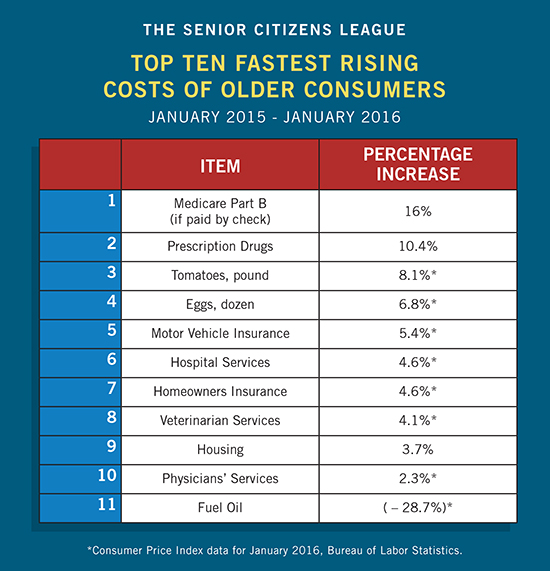(Washington, DC) – Even though inflation was too low for a cost – of – living adjustment (COLA) this year, a number of crucial items that older consumers typically buy jumped in cost, according to a new chart released today by The Senior Citizens League (TSCL). “These cost increases are forcing older consumers to make difficult choices,” says TSCL Chairman, Ed Cates. “In the years when Social Security benefits don’t keep up with rising costs, people living on fixed incomes are forced to spend retirement savings faster than planned or worse, go into debt, just to make ends meet,” says Cates.
The following chart illustrates ten of the biggest cost increases over the past year in items most likely to be found in a typical retiree’s household budget.
“While the majority of Medicare beneficiaries did NOT have an increase in their Medicare Part B premiums this year, about one – third pay 16 percent more in premiums than they paid last year — one of the biggest increases in Medicare premiums on record,” Cates says. “This especially affects people who have delayed the start of their Social Security benefits and pay for their Medicare by check,” Cates explains. Over time however, TSCL studies indicate that Medicare Part B premium, increases are one of the top fastest – growing costs during most retirement years.
Prescription drug costs are another category that TSCL is receiving a lot of comments about from people age 60 and over. “There have been several back – to – back years recently of extreme prescription drug price spikes,” Cates says. TSCL used data from Truveris, a healthcare data company that tracks thousands of drug prices, which showed that prescription drug prices rose 10.43 percent in 2015. TSCL supports legislation that would allow Medicare greater authority to negotiate drug prices.
The cost of eating a more healthy diet rose while the cost of foods higher in fat and cholesterol like processed meats and cheese tumbled. The cost of a pound of tomatoes rose 8.1 percent, almost as much as the average increase in prescription medicines.
Although the cost increase of doctor visits was one of the slower growing increases at 2.3 percent, the price of veterinarian care for pets rose 4.1 percent, nearly double the rate of physician costs. TSCL believes that’s due to the effect of insurers negotiating discounts from doctors for human care. But the same is not so much the case with pet medical care because most people don’t have insurance for the pets.
“The takeaway is that, although the huge drop in fuel oil costs is only one area of spending, it’s big enough to drive down the COLA — even though older Americans drive less as they get older,” Cates says. Research for TSCL indicates that using a seniors CPI — like the Consumer Price Index for the Elderly (CPI-E) — would pay a higher COLA in most years, even in 2016. TSCL is lobbying for an Emergency COLA, as well as legislation that would pay a more fair and accurate COLA by switching to the CPI-E.
How are you affected by rising costs? Take TSCL’s annual Senior Survey— visit www.SeniorsLeague.org.
###
With 1.2 million supporters, The Senior Citizens League is one of the nation’s largest nonpartisan seniors groups. Its mission is to promote and assist members and supporters, to educate and alert senior citizens about their rights and freedoms as U.S. Citizens, and to protect and defend the benefits senior citizens have earned and paid for. The Senior Citizens League is a proud affiliate of The Retired Enlisted Association. Visit www.SeniorsLeague.org for more information.


